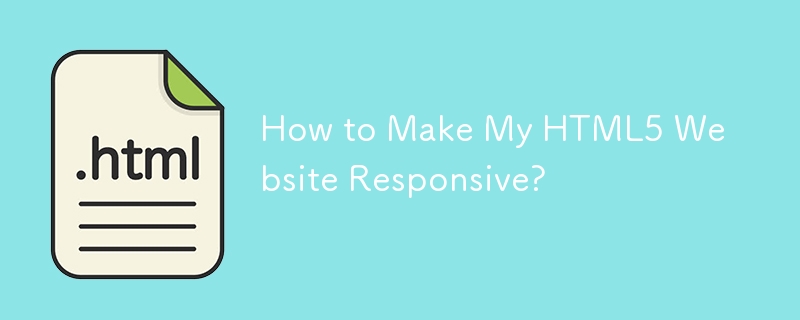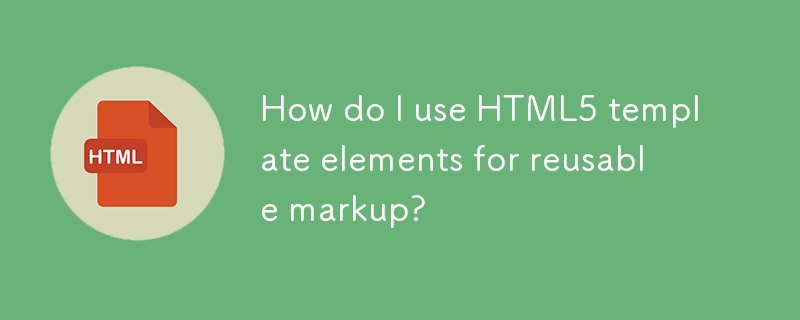Found a total of 10000 related content

HTML5 Template: A Base Starter HTML Boilerplate for Any Project
Article Introduction:Building your own HTML5 template: A concise guide
This article will guide you on how to create your own HTML5 template. We will step by step explaining the key elements of the HTML basic template, and finally providing a simple template that you can use and further build.
After reading this article, you will have your own HTML5 template. If you want to get the HTML template code now, read this article later, here is our final HTML5 template.
Key Points
HTML5 templates, as reusable templates, contain the necessary HTML elements, help avoid repeated code writing at the beginning of each project.
A basic HTML5 template should contain document type declarations, elements with language attributes, and passed characters
2025-02-08
comment 0
772

How to create a responsive video grid in HTML5
Article Introduction:Use HTML5 elements to build a video grid in the container, and each video is wrapped with a div; 2. Use CSSGrid to set display:grid and grid-template-columns:repeat(auto-fit,minmax(300px,1fr)) to achieve responsive layout; 3. Maintain a 16:9 aspect ratio through object-fit or padding-bottom:56.25%; 4. Avoid automatic playback, add controls and posters to ensure mobile availability; and finally realize a cross-device responsive video grid without JavaScript through modern CSS.
2025-08-11
comment 0
678

How to Make My HTML5 Website Responsive?
Article Introduction:This article details creating responsive HTML5 websites. It emphasizes using viewport meta tags, flexible layouts (with relative units), CSS media queries, and responsive images. Various CSS frameworks (Bootstrap, Tailwind CSS, etc.) and testing me
2025-03-10
comment 0
457

Applying HTML5 Principles to Responsive Web Design
Article Introduction:HTML5 improves responsive design through semantic tags, viewport control, responsive pictures and form optimization. 1. Use semantic tags such as, etc. to improve structural clarity, making it easier to flexibly arrange content blocks according to different devices; 2. By controlling mobile display, ensure that the page is correctly scaled and improve the mobile experience; 3. Use responsive image loading with tags, load adaptive resources according to screen size, and improve performance; 4. Use HTML5 form types such as email and tel to optimize mobile input, trigger the corresponding keyboard to improve user experience.
2025-07-15
comment 0
227

How to write a basic HTML5 page template?
Article Introduction:Declare the document as HTML5 to avoid the browser from entering weird mode; 2. Define the root element and specify the language to improve accessibility and SEO; 3. It includes ensuring correct character encoding, implementing responsive design, and setting page title; 4. Place all visible content, optionally add CSS, favicon and JavaScript links; this template is complete and compatible with modern browsers, and is suitable for any new HTML file.
2025-07-26
comment 0
1040

How to make a responsive navigation menu with HTML5
Article Introduction:To create a responsive navigation menu, you must first use HTML5 semantics, then implement desktop layout through CSSFlexbox, and use media queries and JavaScript to display and interact with mobile hamburger menus, ultimately implement cross-device compatible smooth responsive navigation.
2025-08-18
comment 0
983

How to create a responsive HTML5 gallery
Article Introduction:Creating responsive HTML5 galleries requires no complex frameworks, just use semantic HTML and modern CSS. First, build a basic HTML structure containing the image container, and add a viewport meta tag to ensure mobile adaptation; then use CSSGrid to set the grid-template-columns:repeat(auto-fit,minmax(250px,1fr)) of CSSGrid to achieve an adaptive grid layout, cooperate with gap to control spacing, maintain image proportions through object-fit:cover, and improve interactive experience with hover scaling; at the same time, optimize performance, use compressed images, alt text and loading=&qu
2025-09-08
comment 0
239

How to create a responsive design with HTML5
Article Introduction:The key to creating a responsive design is to combine HTML5 structure and CSS. First, you must add a viewport meta tag to ensure the page is scaled correctly. Then use HTML5 semantic tags such as header, nav, main, etc. to build a clear document structure. Then, you can achieve flexible layout through the relative units, Flexbox or Grid layout in CSS, adjust the style for different screen sizes in combination with media queries, and finally set the max-width:100% of img and optimize the image display using picture elements to achieve a responsive website that is adapted to the entire device.
2025-08-18
comment 0
649

How do I use HTML5 template elements for reusable markup?
Article Introduction:The article discusses using HTML5 <template> elements for reusable markup, their benefits for code consistency, performance improvements, and integration with JavaScript for dynamic content.
2025-03-17
comment 0
381

Creating Reusable Content Structures with HTML5 Template Tag
Article Introduction:HTML5 tags are used to create reusable lazy content structures. The specific steps are: 1. Define the template; 2. Obtain and clone the template content through JavaScript; 3. Insert the clone content into the page. Its features include default invisible, support for any HTML, and require JS operations. It is suitable for scenarios such as component structure, dynamic loading, and preloading resources. The scripts and styles in the template need to be specially processed and cannot be nested in specific tags.
2025-07-06
comment 0
960

How to make a responsive image gallery with HTML5?
Article Introduction:To create a responsive picture gallery, the core is to use HTML5 and CSS to achieve adaptation of structure and layout. 1. Use and semantic organization of image content; 2. Use CSSGrid or Flexbox for responsive layout, and Grid is recommended to automatically adjust the multi-column arrangement of the number of columns; 3. Set the image width 100%, adapt highly and use object-fit to maintain proportional filling; 4. Pay attention to details such as gap, minmax and alt attributes to improve aesthetics and accessibility.
2025-07-09
comment 0
706

How to create a responsive HTML5 layout without a framework?
Article Introduction:Use semantic HTML5 elements (such as header, main, aside, footer) to build an accessible and easy-to-maintenance structure; 2. Use CSSGrid or Flexbox to implement layout. Grid is suitable for two-dimensional page layout. In the example, the area is defined through grid-template-areas and stacked vertically on mobile devices; 3. Responsive design is realized through media query, and the font size, navigation direction (mobile device vertical, desktop horizontal) and layout structure are adjusted according to different screen sizes; 4. Optimize image and touch targets, set the maximum width of img to 100%, and ensure that the minimum height of links and buttons is 44px to improve the mobile experience; finally, through viewport meta tags and languages
2025-08-12
comment 0
128

How to make an HTML5 video responsive?
Article Introduction:To make HTML5 video responsive, you need to use a container and CSS to maintain the aspect ratio. 1. Use a div to wrap the video element; 2. Set the container width 100%, height 0, padding-bottom to 56.25% (16:9) or other proportions (such as 75% for 4:3); 3. Set the video to absolute positioning, width 100%, object-fit to cover or contain; 4. Optionally set max-width and margin:0auto to limit the maximum width and center; this method is implemented in pure CSS, compatible with modern browsers, and can adapt to different screen sizes.
2025-08-03
comment 0
438

How to use the picture element for responsive images in HTML5
Article Introduction:Elements using HTML5 can provide responsive images based on screen size, resolution or device orientation, and image loading under different conditions is achieved by combining the media and type attributes of the tag, and as a backup, ensuring compatibility and performance optimization. It is ideal when art guidance or modern format support is required, and only the srcset attribute that can be used when resolution switching is required.
2025-08-12
comment 0
850

Using the HTML5 `` element for reusable content.
Article Introduction:Elements are native tools in HTML5 for storing unreleased HTML fragments, and can be efficiently reused after cloning through JavaScript. 1. Get template nodes; 2. Cloning content; 3. Filling data; 4. Inserting page. When using it, you need to pay attention to: the content and styles must be accessed through cloning, and must be defined separately and compatible with modern browsers. Suitable scenarios include dynamic lists, pop-up components, table rows and other duplicate structures.
2025-07-08
comment 0
508

How do you create a responsive video in HTML5?
Article Introduction:To create a responsive HTML5 video, you must first use CSS to control the aspect ratio, and then achieve adaptation through containers and absolute positioning; 1. Use tags and add controls, preload="metadata" and other attributes; 2. Wrap the video in a div with class as a video-container; 3. Use CSS to set the padding-bottom of the container to 56.25% to maintain the 16:9 aspect ratio; 4. Set position:absolute, top:0, left:0, width:100%, height:100% and object-fit:cover for the video; 5.
2025-08-06
comment 0
310

How to create a responsive navigation menu in HTML5?
Article Introduction:Use elements of semantic HTML5 to build a navigation structure. 2. Use CSSFlexbox to layout the desktop menu and hide the mobile buttons. 3. Show the hamburger icon on the small screen through media queries and hide the menu. 4. Use JavaScript to switch the menu and icon status. 5. Automatically close the mobile menu after clicking the link. It must include the viewport meta tag, adopt the flex layout, and the menu sliding has a transition effect, ultimately realizing cross-device responsive navigation.
2025-08-11
comment 0
417

Implementing Responsive Images with the HTML5 Picture Element
Article Introduction:Elements are container elements introduced by HTML5 for implementing responsive pictures, which select the most suitable image resource according to device characteristics through multiple and one tag. 1. It supports loading adaptive pictures according to different screen widths to improve loading performance; 2. It can provide priority to modern formats such as WebP, which will fall back to traditional formats if not supported; 3. It can switch different compositions according to the aspect ratio of the device to optimize visual display; in addition, it is always necessary to add descriptive alt text, ensure correct paths, test compatibility and standardized naming to improve maintainability.
2025-07-14
comment 0
571

How to use the HTML5 picture element for responsive images
Article Introduction:The core of using HTML5's picture elements to implement responsive pictures is to load the most suitable image resources according to the device characteristics. The specific methods are as follows: 1. The elements contain multiple and one, and the browser matches the conditions in order that meets the conditions, otherwise it will fall back; 2. Combining the srcset and sizes attributes, let the browser automatically choose the best size; 3. Prioritize loading of modern formats (such as WebP) by specifying the type attribute, and downgrade supporting traditional formats; 4. Pay attention to order, retain as fallback, consider compatibility and SEO optimization.
2025-07-05
comment 0
895

Using HTML5 Source Set for Responsive Images (srcset)
Article Introduction:How to implement responsive image loading on different devices? Use HTML5's srcset and sizes properties. The specific methods are: 1. Prepare pictures of multiple sizes and mark the width with w units; 2. Define the viewport ratio of pictures under different screen widths in sizes, such as (max-width: 600px)100vw; 3. Pay attention to setting DPR high-definition adaptation, such as 1x/2x descriptor; 4. Always keep src as a compatibility solution; 5. Plan the image size according to the device breakpoint, such as 480px/768px/1024px, etc.; 6. Test the loading effect of each size through the developer tool. This ensures that the browser accurately selects the best picture, taking into account loading speed and display quality.
2025-07-05
comment 0
452



















